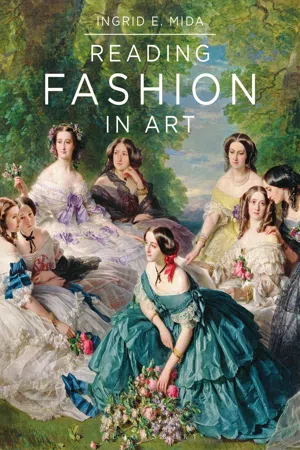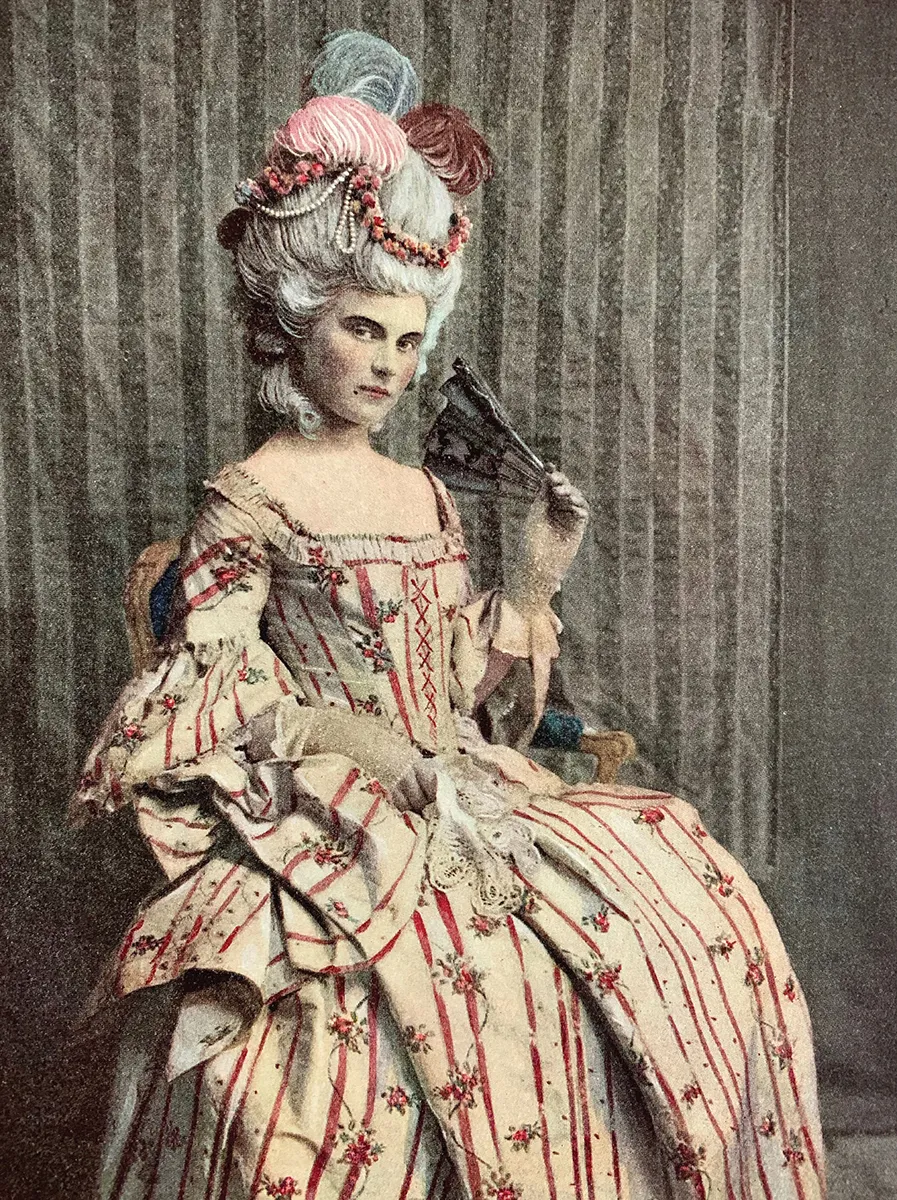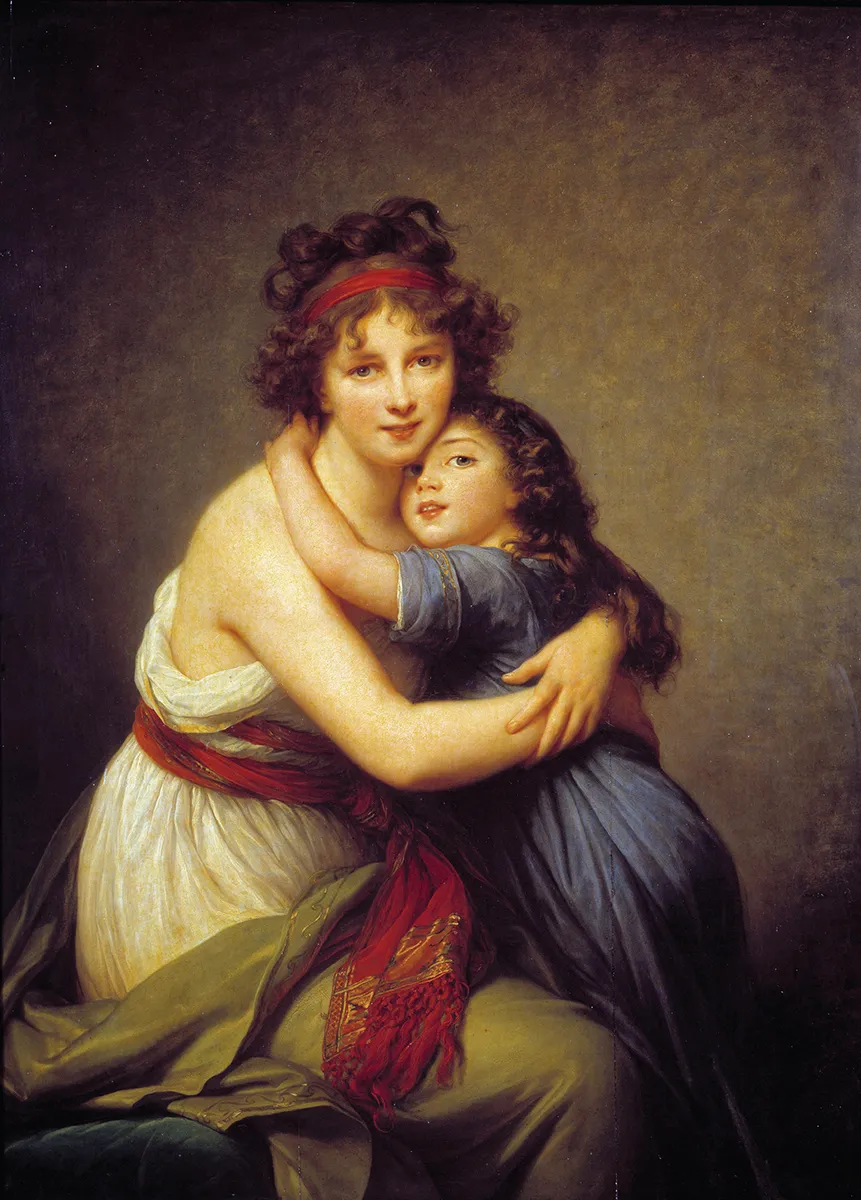![]()
INTRODUCTION
Prior to the widespread adoption of photography, it would take an artist many days of work to create a portrait and render the complex folds, textures, and patterns of the sitter’s clothing,1 especially if the model was wearing a dress of striped French brocade like that illustrated in Figure 1.1. To streamline this process and spare the sitter the long, grueling hours of having to stand or sit without moving, portrait artists crafted solutions of various kinds, including hiring models or using servants as stand-ins for their sitters, and/or using wooden mannequins dressed in the sitter’s clothing.2 Some portrait painters, like Joshua Reynolds (1723–1792) hired drapery specialists.3 Artists also appropriated ideas and looks from fashion plates, and many artists borrowed, rented, or purchased garments for use as props in their studios.4 Some artists even amassed large collections of dress, including the English-born genre painter Talbot Hughes (1869–1942), who once owned the eighteenth-century gown shown in Figure 1.1 and whose significant collection of historic dress was transferred to the Victoria & Albert Museum in 1913.5
With the invention of photography in the mid-nineteenth century, the ease and pleasure of having a likeness of one’s self became accessible to all and not only reduced the demand for painted portraits but changed how many artists worked. This chapter provides a brief overview of the myriad of ways that artists have harnessed fashion in creating their figurative works and is divided into two parts to correspond with the periods before and after the invention of photography. The first part, “Before Photography,” begins with a discussion of how leading eighteenth-century portraitists Adélaïde Labille-Guiard (1749–1803), Elisabeth Vigée Le Brun (1755–1842), Joshua Reynolds (1723–1792), and Thomas Gainsborough (1727–1788), used clothing and drapery in their figurative works. The second part, “After the Invention of Photography,” considers the impact of this technological development on portraiture and figurative works. The key idea of this chapter is that cloth and clothing are artistic tools in the creation of the work and must be read with care.
Figure 1.1
Bertram Park, A Dress of Charming Proportion in Beautiful French Brocade, Period 1775–85, 1913. Hand-colored photograph, Plate 18 in Old English Costumes: A Sequence of Fashions through the Eighteenth and Nineteenth Centuries.
BEFORE PHOTOGRAPHY
For an artist, a self-portrait dispenses with the need to hire a model and can also serve as a calling card. In Adélaïde Labille-Guiard’s self-portrait with two students dated 1785 (Figure 1.2), she wears a seemingly impractical choice of dress for the messy work of a painter: a beautiful, pale blue, silk satin robe à l’anglaise gown with low décolletage trimmed with delicate lace and lined in white silk. Her two pupils, Marie Gabrielle Capet and Marie Marguerite Carreaux de Rosemond, stand behind her chair and are dressed more simply and modestly. From the artist’s selection of elegant attire for herself, it is clear that she wants us to admire her skill in rendering the lustrous sheen and complex folds of her fashionable gown as well as the downy texture of the delicate ostrich feathers that top her large brimmed straw hat. This dress and her ostrich-trimmed hat are very similar to ensembles found in fashion plates from Galerie des Modes et Costume Français ca. 1784.6 At this time in France, women artists who publicly exhibited their work were “criticized for their immodesty.”7 Although the low décolletage of the gown worn by Labille-Guiard reveals the gentle curves of her breasts, this “immodesty” is countered somewhat by the inclusion of two classical sculptures in the background (including a sculpture of her father and one of the Vestal Virgin).
Figure 1.2
Adélaïde Labille-Guiard, Self-Portrait with Two Pupils, Marie Gabrielle Capet and Marie Marguerite Carreaux de Rosemond, 1785. Oil on canvas (210.8 × 151.1 cm).
As well, the crisp handling of paint on this monumental canvas, a size and format more typically associated with male artists, suggests that Labille-Guiard was challenging the notion that women could not undertake such work.8 At this time, the number of women allowed in the French Academy was limited to four by the King’s decree.9 Labille-Guiard was admitted to the Academie Royale in 1783 but faced obstacles in finding society patrons since she had left her husband and lived in modest lodgings.10 In light of Labille-Guiard’s decision to teach rather than pursue a society clientele, this canvas can be read as a propaganda piece that argues for the admission of more women to the French Academy. In this case, the dress worn by the artist in her self-portrait embodies both an artistic and a political statement.
In contrast, the celebrated portraitist Elisabeth Vigée Le Brun (whose 1783 Salon portrait of Marie Antoinette was discussed at length in the introduction to this book) chose to dress informally for her self-portrait called Self-Portrait with Cerise Ribbons dated 1782 (Figure 1.3). In this work, Vigée Le Brun wears the robe en gaulle and showcases her ability to deftly render the delicate fabric, as well as capture the intricate texture of the lacy shawl draped over her shoulders and the iridescence of her opal earrings. In her memoirs, Vigée Le Brun recounted that she preferred to wear these “white dresses of muslin or lawn” but also had other formal gowns that were suitable for her trips to Versailles.11 She also indicated that she had strong ideas about how she wanted her sitters to dress and expressed her dislike for the prevailing fashions of the time. When she could, she fashioned the drapery arrangements herself, as she revealed in this quote: “after getting the confidence of my models, I was able to drape them according to my fancy. Shawls were not yet worn, but I made an arrangement with broad scarfs lightly intertwined round the body and on the arms, which was an attempt to imitate the beautiful drapings by Raphael and Domenichino.”12 Vigée Le Brun’s 1789 self-portrait with her daughter (Figure 1.4) illustrates this type of artistic draping of cloth, creating an image that is difficult to date with its allusions to classical antiquity. Vigée Le Brun was not the only artist to employ this type of classical drapery in portraiture.
Figure 1.3
Elisabeth Vigée Le Brun, Self-Portrait with Cerise Ribbons, 1782. Oil on canvas (64.8 × 54 cm).
Figure 1.4
Elisabeth Vigée Le Brun, Self-Portrait with Daughter Julie (à l’Antique), 1789. Oil on wood (130 × 94 cm).
Sir Joshua Reynolds, the founder of the Royal Academy of Arts in London, also preferred that his sitters wear antiquarian or fancy dress. In his self-portrait from 1780,13 Reynolds wore his academic robes and cap of the University of Oxford from which he had received an honorary doctorate degree in 1776.14 In many ways, this painting recalls the dress and style of Rembrandt’s self-portraits—and no doubt this fashioning of the body was intended to connect his work to that of the Old Masters. In a statement to the members of the Academy in 1776, Reynolds said that it was the role of the portraitist to “dignify his subject, which we will suppose is a lady” and accordingly the artist “will not paint her in the modern dress, the familiarity of which alone is sufficient to destroy all dignity.”15 His contemporary Thomas Gai...




